
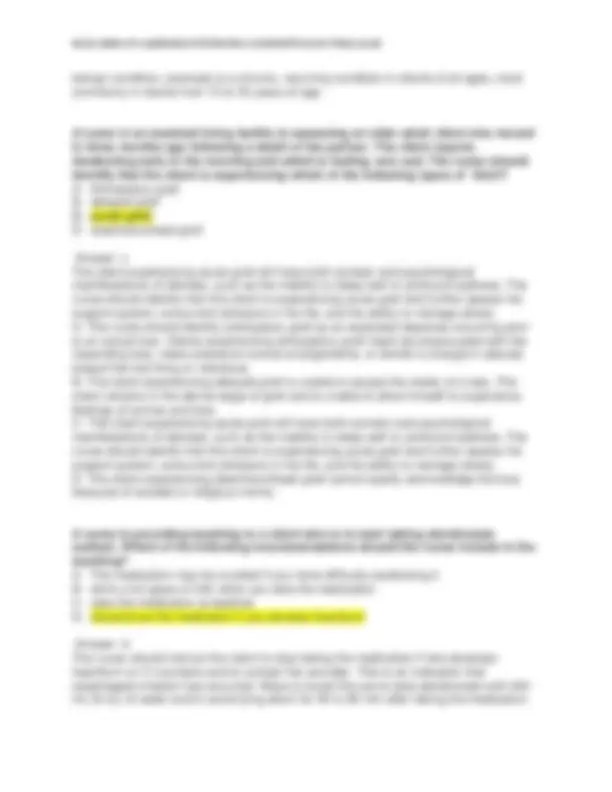
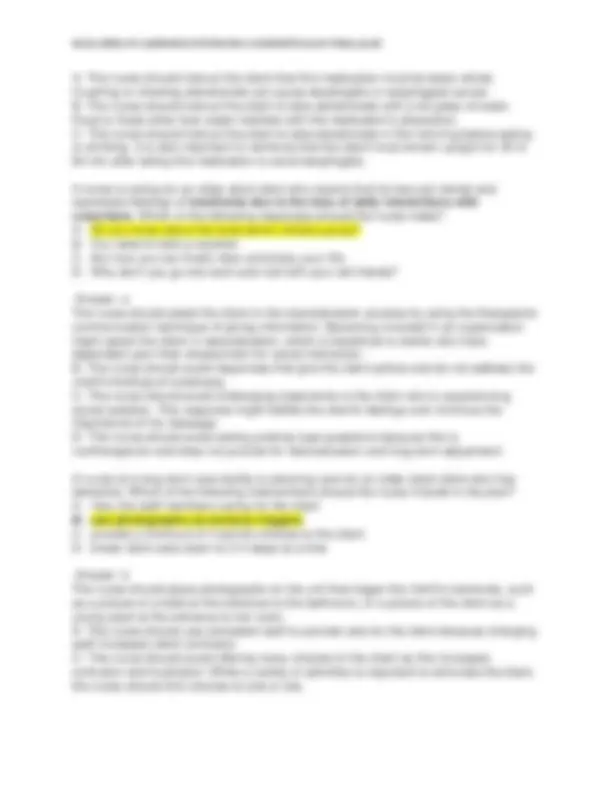
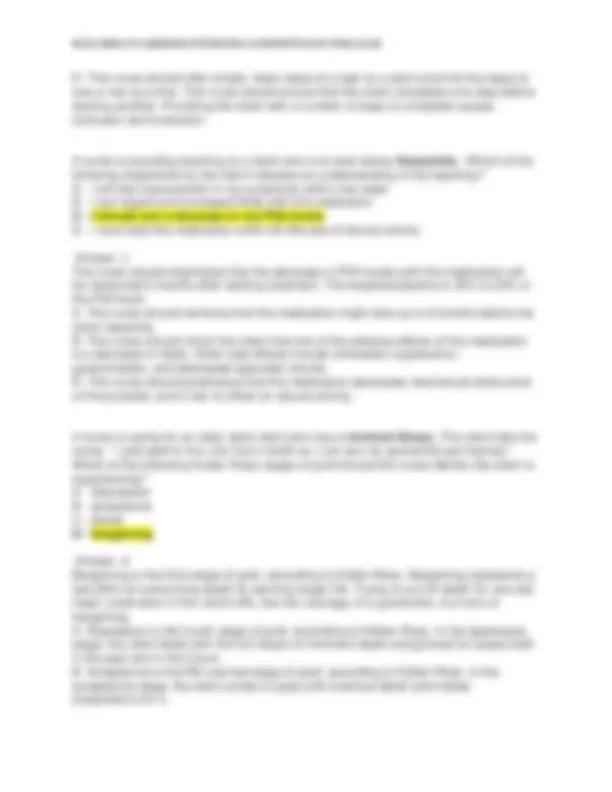
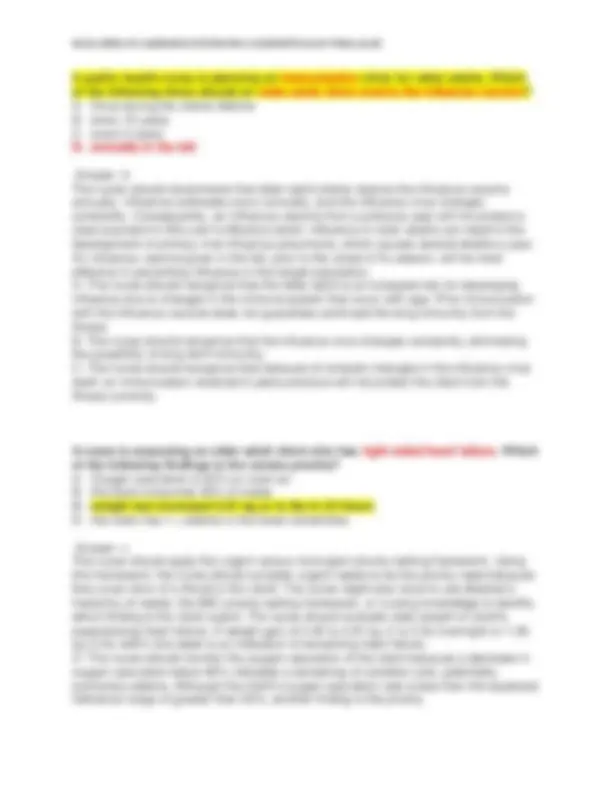
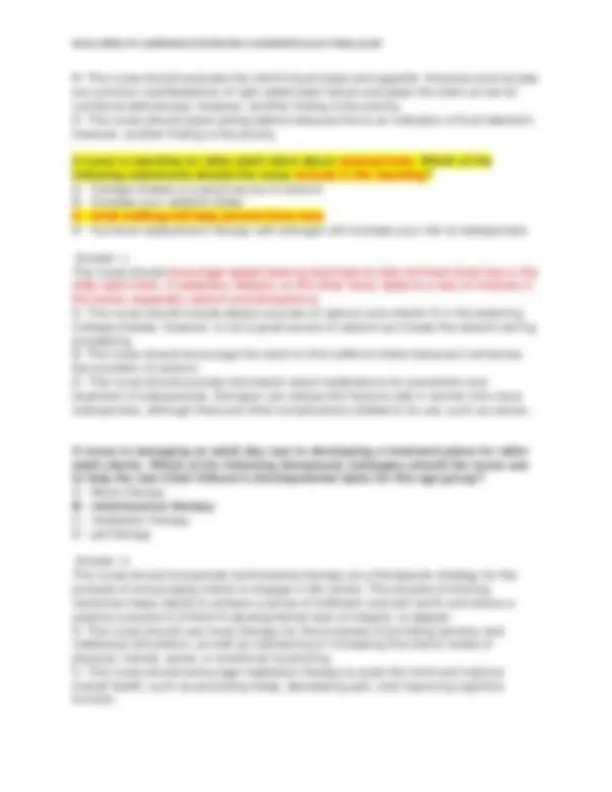
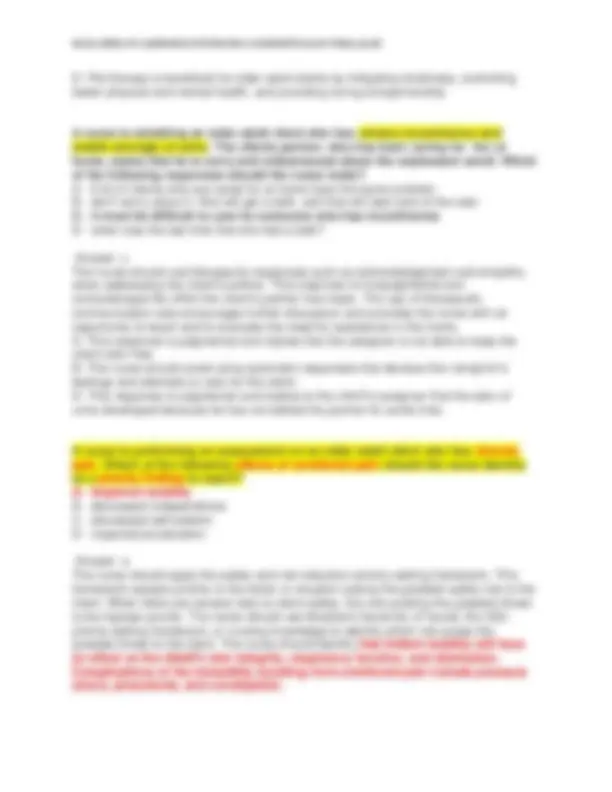
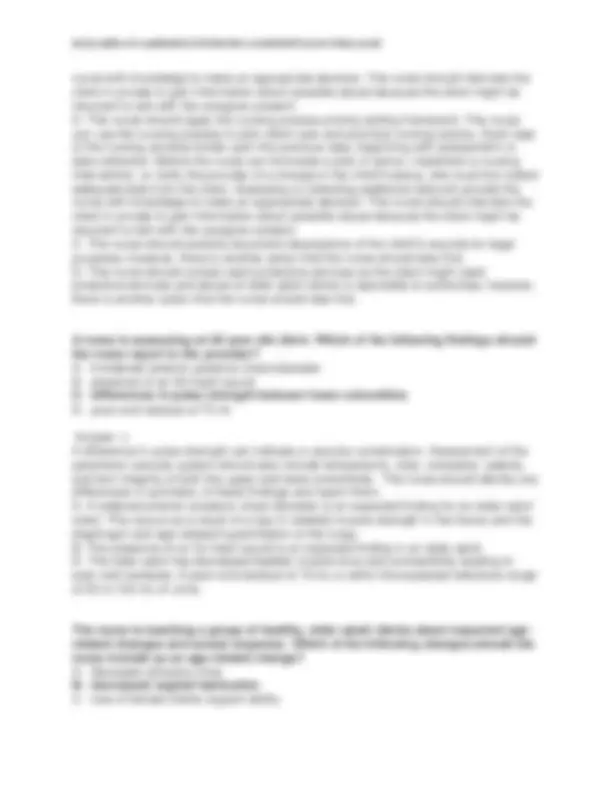
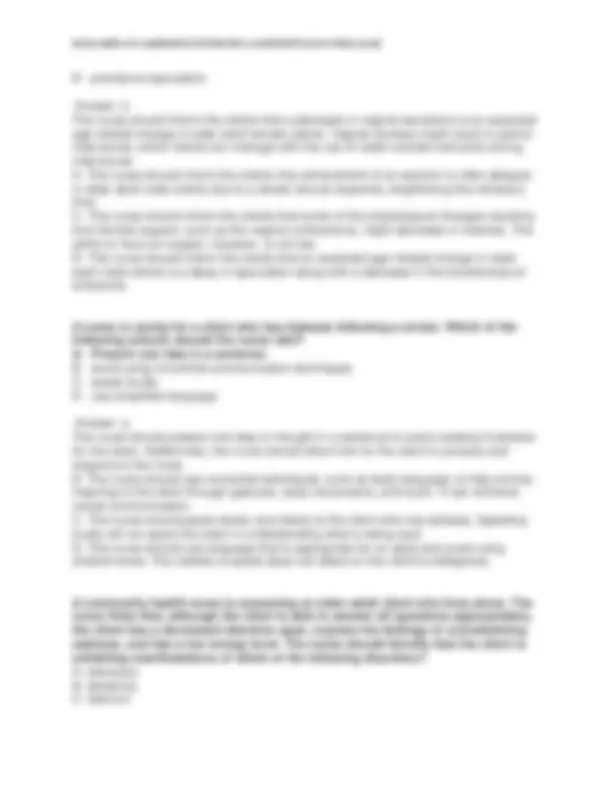
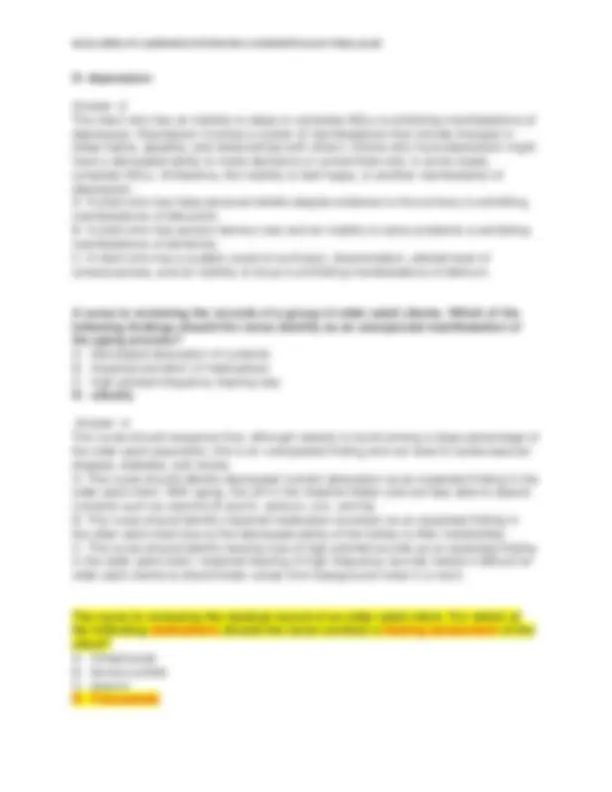
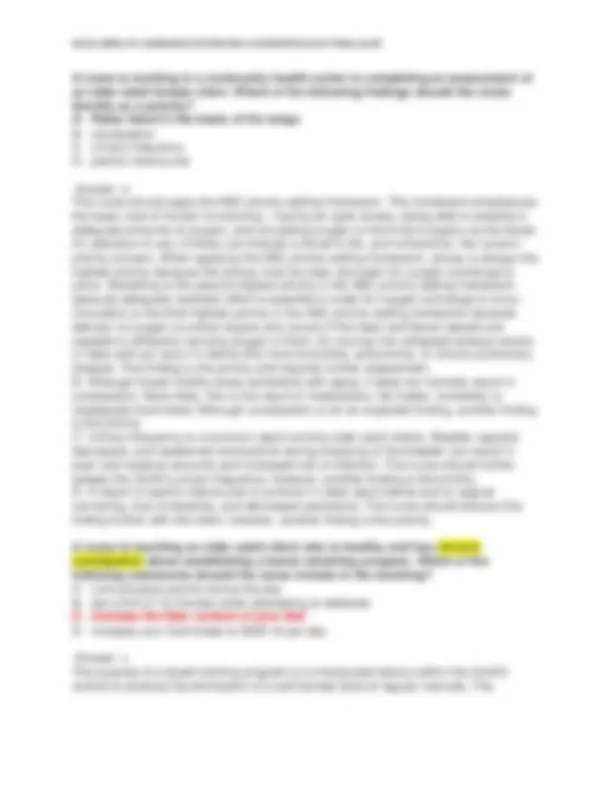
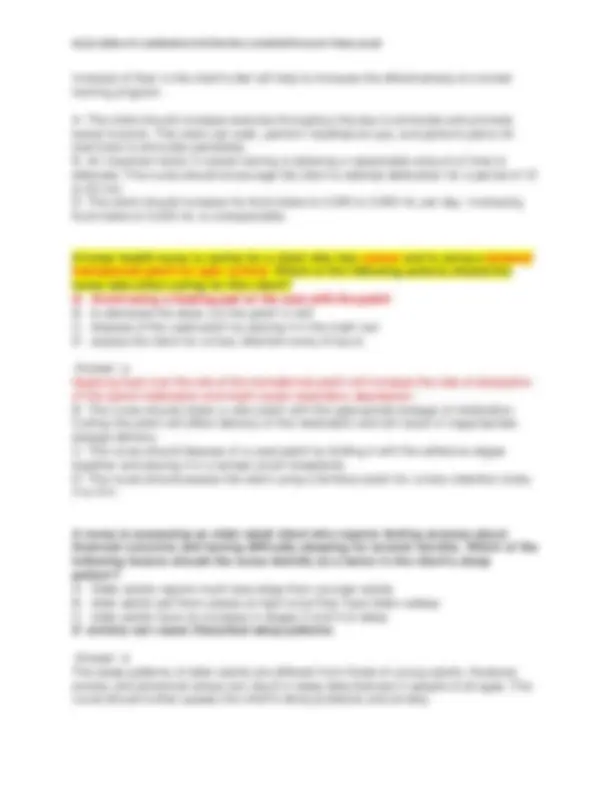
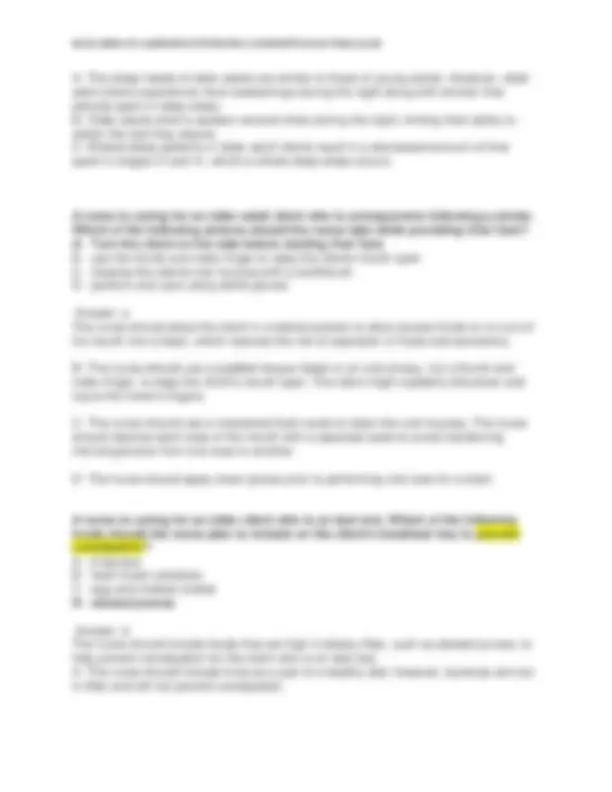
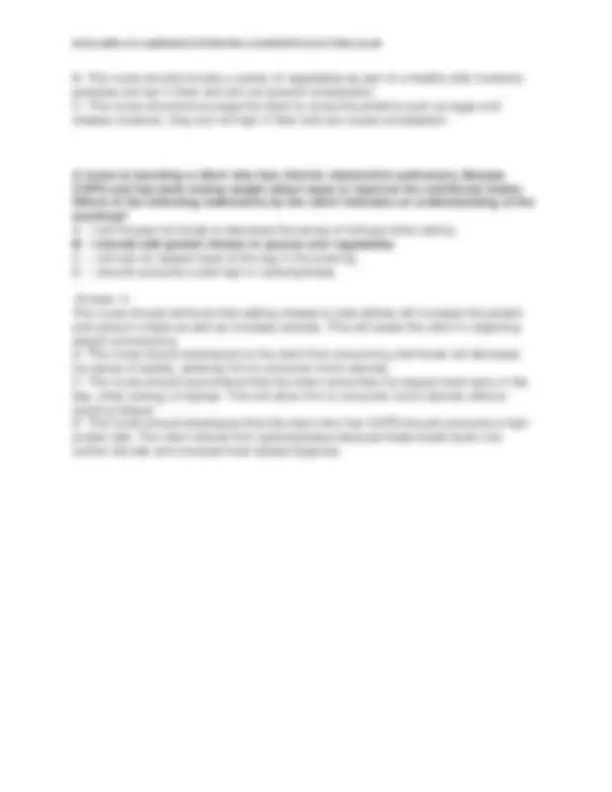


Study with the several resources on Docsity

Earn points by helping other students or get them with a premium plan


Prepare for your exams
Study with the several resources on Docsity

Earn points to download
Earn points by helping other students or get them with a premium plan
Community
Ask the community for help and clear up your study doubts
Discover the best universities in your country according to Docsity users
Free resources
Download our free guides on studying techniques, anxiety management strategies, and thesis advice from Docsity tutors
N212 GERO ATI LEARNING SYSTEM RN 2.0 GERONTOLOGY FINAL QUIZ (with rationales)
Typology: Exams
1 / 21

This page cannot be seen from the preview
Don't miss anything!














A nurse is completing medication reconciliation for an older adult client who is receiving multiple medications. Which of the following actions should the nurse take first? A- Clarify the client list of medications with the pharmacist B- compare the current list against the new medication prescriptions C- investigate any discrepancies on that list D- ask the client about over the counter medications she is taking Answer- D The nurse should apply the nursing process priority-setting framework. The nurse can use the nursing process to plan client care and prioritize nursing actions. Each step of the nursing process builds on the previous step, beginning with assessment or data collection. Before the nurse can formulate a plan of action, implement a nursing intervention, or notify the provider of a change in the client’s status, she must first collect adequate data from the client. Assessing or collecting additional data will provide the nurse with knowledge to make an appropriate decision. When performing medication reconciliation, it is important that the nurse collect a list of all the medications the client takes in order to compare the full list of medications against any new medications the client will take. The list should include prescriptions, over-the-counter medications, and herbal and nutritional supplements. A- The nurse should clarify the client’s list of medications with the pharmacist, caregivers, providers, and the client; however, this is not the first action the nurse should take. B- The nurse should compare the medication list against any new prescriptions to ensure there is not any duplication of medications or potential medication interactions; however, this is not the first action the nurse should take. C- The nurse should investigate discrepancies on the list with the provider to prevent medication errors; however, this is not the first action the nurse should take. Exam 1? A nurse at a long-term care facility is planning care for a client who has Alzheimer's disease and wanders at night. Which of the following interventions should the nurse include in the plan? A- Place the client in wrist restraints at night B- request a prescription for a psychotropic medication C- assign the client to a room closer to the nurses station D- cheap the television on at night Answer- C The nurse should place the client who wanders in a room that allows for close observation. The nurse should provide clients who wander a safe place to walk and supervision when the client is ambulating. A- The nurse should protect the client from harm, but restraints can result in agitation. B- The nurse can administer a psychotropic medication to treat depression or emotional manifestations of Alzheimer’s disease, but not to treat wandering behaviors. D- The nurse should avoid the use of excessive light and sound stimulation for the client who has Alzheimer’s disease. This can cause further agitation and confusion for the client.
The nurse at a long-term care facility is teaching an older adult client about ambulating with a quad cane. Which of the following statements should the nurse include in the teaching? A- Adjust the height of the cane so that you can flex your elbow at 45 degrees B- hold the cane in the hand on the stronger side of your body C- place the flat side of the cane away from your foot D- the cane and your stronger leg at the same time Answer- b The client should hold the cane with the hand on the stronger side of her body so that she can move the cane to support the weaker leg. This action allows for a more normal gait, with the ipsilateral arm and weaker leg moving at the same time. A- The nurse should instruct the client that the cane’s height should allow the elbow to be slightly flexed. Having a flexion of 45º would make the cane too tall for safe use. C- The client should place the flat edge of the base of the cane facing toward her foot. This allows the client to ambulate without the risk of getting her foot caught in the base of the cane and falling. D- The nurse should instruct the client to move the cane and her weaker leg at the same time. This action allows for a more normal gait with the ipsilateral arm and weaker leg moving at the same time. A nurse is performing a skin assessment for a group of older adult clients. Which of the following findings should the nurse identify as a benign, age related skin change commonly seen in older adult clients? A- Liver spots B- Nevi C- atopic dermatitis D- psoriasis Answer- a Liver spots, also known as age spots or lentigines, are flat, brownish-black macules that usually occur in sun-exposed areas of the body. Aging and exposure to sunlight, or other forms of ultraviolet light, can result in increased pigmentation. Liver spots are extremely common after 40 years of age; they occur most often on the forearms, shoulders, face, forehead, and backs of the hands, which are also the areas of highest sun exposure. They are harmless and painless, but they can affect the client’s cosmetic appearance. B- Nevi are moles, a growth of pigment-forming cells that might be benign or malignant. The nurse should identify that nevi occur throughout the lifespan. Further evaluation of the nevi should include evaluation of any asymmetry, border irregularity, color variation, diameter, and evolution, which can indicate melanoma. C- Atopic dermatitis, or eczema, is a chronic skin disorder that occurs in all ages, but is more common in infancy and childhood. Clients who have atopic dermatitis can have scaly and itching rashes. D- Psoriasis is a common skin inflammation with frequent episodes of redness, itching, and thick, dry, silvery scales on the skin. The nurse should identify that while generally a
A- The nurse should instruct the client that this medication must be taken whole. Crushing or chewing alendronate can cause esophagitis or esophageal cancer. B- The nurse should instruct the client to take alendronate with a full glass of water. Food or fluids other than water interfere with the medication's absorption. C- The nurse should instruct the client to take alendronate in the morning before eating or drinking. It is also important to reinforce that the client must remain upright for 30 to 60 min after taking this medication to avoid esophagitis. A nurse is caring for an older adult client who reports that he has just retired and expresses feelings of loneliness due to the loss of daily interactions with coworkers. Which of the following responses should the nurse make? A- Do you know about the local senior citizens group? B- You need to take a vacation. C- But now you can finally relax and enjoy your life. D- Why don't you go into work and visit with your old friends? Answer- a The nurse should assist the client in the resocialization process by using the therapeutic communication technique of giving information. Becoming involved in an organization might assist the client in resocialization, which is beneficial to clients who have depended upon their employment for social interaction. B- The nurse should avoid responses that give the client advice and do not address the client’s feelings of loneliness. C- The nurse should avoid challenging statements to the client who is experiencing social isolation. This response might belittle the client's feelings and minimize the importance of his message. D- The nurse should avoid asking probing-type questions because this is nontherapeutic and does not provide for resocialization and long-term adjustment. A nurse at a long-term care facility is planning care for an older adult client who has dementia. Which of the following interventions should the nurse include in the plan? A- Very the staff members caring for the client B- use photographs as memory triggers C- provide a minimum of 3 activity choices to the client D- break client asks down to 3 - 4 steps at a time Answer- b The nurse should place photographs on the unit that trigger the client’s memories, such as a picture of a toilet at the entrance to the bathroom, or a picture of the client as a young adult at the entrance to her room. A- The nurse should use consistent staff to provide care for the client because changing staff increases client confusion. C- The nurse should avoid offering many choices to the client as this increases confusion and frustration. While a variety of activities is important to stimulate the client, the nurse should limit choices to one or two.
D- The nurse should offer simple, basic steps of a task to a client and limit the steps to one or two at a time. The nurse should ensure that the client completes one step before starting another. Providing the client with a number of steps to complete causes confusion and frustration. A nurse is providing teaching to a client who is to start taking finasteride. Which of the following statements by the client indicates an understanding of the teaching? A- I will see Improvement in my symptoms within one week B- I can expect and increased libido with this medication C- I should see a decrease in my PSA levels D- I must take this medication within 60 Minutes of sexual activity Answer- c The nurse should emphasize that the decrease in PSA levels with this medication will be measured 6 months after starting treatment. The expected decline is 30% to 50% in the PSA level. A- The nurse should reinforce that this medication might take up to 6 months before the client responds. B- The nurse should inform the client that one of the adverse effects of this medication is a decrease in libido. Other side effects include orthostatic hypotension, gynecomastia, and decreased ejaculate volume. D- The nurse should emphasize that this medication decreases mechanical obstruction of the prostate, and it has no effect on sexual activity. A nurse is caring for an older adult client who has a terminal illness. The client tells the nurse, “ I just want to live one more month so I can see my grandchild get married.” Which of the following Kubler-Ross stages of grief should the nurse identify the client is experiencing? A- Depression B- acceptance C- denial D- bargaining Answer- d Bargaining is the third stage of grief, according to Kübler-Ross. Bargaining represents a last effort at overcoming death by earning longer life. Trying to put off death for one last major celebration in the client’s life, like the marriage of a grandchild, is a form of bargaining. A- Depression is the fourth stage of grief, according to Kübler-Ross. In the depression stage, the client deals with the full impact of imminent death and grieves for losses both in the past and in the future. B- Acceptance is the fifth and last stage of grief, according to Kübler-Ross. In the acceptance stage, the client comes to grips with eventual death and makes preparations for it.
A nurse is teaching an older adult client about methods to improve sleep. Which of the following statements should the nurse include in the teaching? A- Go to bed at the same time every night B- watch television in bed until you are sleepy C- drink a glass of wine before going to bed D- engage in physical activity in the evening Answer- a The nurse should recommend that the client keep consistent sleep and wake times, even on the weekends. Having a regular sleep schedule will help minimize the alterations to the circadian rhythm that occurs in the older adult client. B- The nurse should discourage the client from watching television or performing any work in bed because this disrupts sleep quality. Instead, the nurse should recommend light reading or listening to relaxing music to assist the client in falling asleep. C- The nurse should discourage the use of alcohol or caffeine products prior to bedtime because these are stimulants and diuretics and inhibit sleep. Instead, the client can have a light carbohydrate or a glass of milk as a bedtime snack. D- The nurse should recommend the client participate in physical activity during the daytime as this can enhance sleep. However, the client should not participate in physical activity within 3 hr prior to bedtime because this can impair sleep. A nurse is caring for a client who is using a continuous passive motion CPM device following a right total knee replacement. Which of the following actions should the nurse take when applying the CPM device? A- Apply the CPM device in the flex position B- line up the frame joints of the CPM device with the clients knee C- check the range of motion settings on the CPM device daily D- place the head of the clients bed at 45 degrees during CPM use Answer- b To avoid damage to the operative knee, the nurse should line up the joints of the CPM machine with the client’s operative knee. A- The nurse should apply the CPM device while it is in the extended position for client comfort and to ensure proper placement. C- The nurse should assess the settings on the CPM device every 8 hr to ensure the appropriate flexion and extension cycle is occurring. D- The nurse should initially place the client in a supine position when applying the CPM device. Following placement, the nurse should place the head of the bed at 20º if the client is able to tolerate this angle.
A public health nurse is planning an immunization clinic for older adults. Which of the following times should an older adult client receive the influenza vaccine? A- Once during the clients lifetime B- every 10 years C- every 5 years D- annually in the fall Answer- d The nurse should recommend that older adult clients receive the influenza vaccine annually. Influenza outbreaks occur annually, and the influenza virus changes constantly. Consequently, an influenza vaccine from a previous year will not protect a client exposed to this year’s influenza strain. Influenza in older adults can result in the development of primary viral influenza pneumonia, which causes several deaths a year. An influenza vaccine given in the fall, prior to the onset of flu season, will be most effective in preventing influenza in this target population. A- The nurse should recognize that the older adult is at increased risk for developing influenza due to changes in the immune system that occur with age. Prior immunization with the influenza vaccine does not guarantee continued life-long immunity from the illness. B- The nurse should recognize that the influenza virus changes constantly, eliminating the possibility of long-term immunity. C- The nurse should recognize that because of constant changes in the influenza virus itself, an immunization received 5 years previous will not protect the client from the illness currently. A nurse is assessing an older adult client who has right-sided heart failure. Which of the following findings is the nurses priority? A- Oxygen saturation is 92% on room air B- the client consumes 20% of males C- weight has increased 0.91 kg or to lbs in 24 hours D- the client has 1 + edema in the lower extremities Answer- c The nurse should apply the urgent versus nonurgent priority-setting framework. Using this framework, the nurse should consider urgent needs to be the priority need because they pose more of a threat to the client. The nurse might also need to use Maslow’s hierarchy of needs, the ABC priority-setting framework, or nursing knowledge to identify which finding is the most urgent. The nurse should evaluate daily weight of client’s experiencing heart failure. A weight gain of 0.45 to 0.91 kg (1 to 2 lb) overnight or 1. kg (3 lb) within one week is an indication of worsening heart failure. A- The nurse should monitor the oxygen saturation of the client because a decrease in oxygen saturation below 90% indicates a worsening of condition and, potentially, pulmonary edema. Although the client’s oxygen saturation rate is less than the expected reference range of greater than 93%, another finding is the priority.
D- Pet therapy is beneficial for older adult clients by mitigating loneliness, promoting better physical and mental health, and providing loving companionship. A nurse is admitting an older adult client who has urinary incontinence and smells strongly of urine. The clients partner, who has been caring for her at home, states that he is sorry and embarrassed about the unpleasant smell. Which of the following responses should the nurse make? A- A lot of clients who are cared for at home have the same problem B- don't worry about it. She will get a bath, and that will take care of the odor C- it must be difficult to care for someone who has incontinence D- when was the last time that she had a bath? Answer- c The nurse should use therapeutic responses such as acknowledgement and empathy when addressing the client’s partner. This response is nonjudgmental and acknowledges the effort the client’s partner has made. The use of therapeutic communication also encourages further discussion and provides the nurse with an opportunity to teach and to evaluate the need for assistance in the home. A- This response is judgmental and implies that the caregiver is not able to keep the client odor-free. B- The nurse should avoid using automatic responses that devalue the caregiver’s feelings and attempts to care for the client. D- This response is judgmental and implies to the client’s caregiver that the odor of urine developed because he has not bathed his partner for some time. A nurse is performing an assessment on an older adult client who has chronic pain. Which of the following effects of unrelieved pain should the nurse identify as a priority finding to report? A- Impaired mobility B- decreased Independence C- decreased self-esteem D- impaired socialization Answer- a The nurse should apply the safety and risk reduction priority-setting framework. This framework assigns priority to the factor or situation posing the greatest safety risk to the client. When there are several risks to client safety, the one positing the greatest threat is the highest priority. The nurse should use Maslow’s hierarchy of needs, the ABC priority-setting framework, or nursing knowledge to identify which risk poses the greatest threat to the client. The nurse should identify that limited mobility will have an effect on the client’s skin integrity, respiratory function, and elimination. Complications of the immobility resulting from unrelieved pain include pressure ulcers, pneumonia, and constipation.
B- The nurse should address the limitations to the client’s independence that unrelieved pain causes and the increased need for assistance with ADLs because this can negatively impact the client’s self-esteem and well-being; however, there is another finding that is the priority. C- The nurse should more fully assess the effect that a decrease in self-esteem has on the client as this can negatively affect nutrition, motivation, and well-being; however, there is another finding that is the priority. D- The nurse should evaluate the impact the impaired socialization has on the client and assist the client in finding ways to regain social contacts since impaired socialization can have a negative effect on mood and cognition; however, there is another finding that is the priority. A nurse is conducting an in-service for a group of assistive Personnel about the basic needs of older adult clients. Which of the following statements should the nurse include in the teaching? A- Caloric needs are increased B- renal function is increased C- deep sleep is decreased D- exercise needs are decreased Answer- c The sleep architecture, or time spent in various stages of sleep, changes with aging. The older adult spends less time in stages III and IV, which are the stages of deep sleep. This decrease in time spent in deep sleep can delay healing. A- The caloric needs of an older adult client are decreased. The basal metabolic rate in older adult clients slows and can decline by 10% from the metabolic rate of a younger adult. B- Older adult clients have decreased renal function, affecting the body’s ability to concentrate urine and filter wastes. D- Exercise needs for older adult clients are the same as for younger adults, with recommendations of 30 min a day for 5 or more days a week. Regular exercise provides health benefits for older adult clients, including improvements in blood pressure, lipid profile, and neurocognitive function. Older adults who perform regular physical activity have decreased mortality and age-related morbidity. A nurse is caring for an older adult client who is expressing feelings of grief and longing for his earlier life. Which of the following actions should the nurse take? A- Listen attentively and allow the client to talk about the past B- change the topic of conversation C- let the client know that this is a common issue for older adult clients D- tell the client about some younger clients who are in worse shape than he is Answer- a The nurse should encourage the client to reminisce as a means of dealing with his feelings of grief and longing. This is the therapeutic technique of offering self. Listening
nurse with knowledge to make an appropriate decision. The nurse should interview the client in private to gain information about possible abuse because the client might be reluctant to talk with the caregiver present. A- The nurse should apply the nursing process priority-setting framework. The nurse can use the nursing process to plan client care and prioritize nursing actions. Each step of the nursing process builds upon the previous step, beginning with assessment or data collection. Before the nurse can formulate a plan of action, implement a nursing intervention, or notify the provider of a change in the client’s status, she must first collect adequate data from the client. Assessing or collecting additional data will provide the nurse with knowledge to make an appropriate decision. The nurse should interview the client in private to gain information about possible abuse because the client might be reluctant to talk with the caregiver present. C- The nurse should carefully document descriptions of the client’s wounds for legal purposes; however, there is another action that the nurse should take first. D- The nurse should contact adult protective services as the client might need protective services and abuse of older adult clients is reportable to authorities; however, there is another action that the nurse should take first. A nurse is assessing an 85 year old client. Which of the following findings should the nurse report to the provider? A- A widened anterior posterior chest diameter B- presence of an S4 heart sound C- differences in pulse strength between lower extremities D- post void residual of 75 ml Answer- c A difference in pulse strength can indicate a vascular complication. Assessment of the peripheral vascular system should also include temperature, color, sensation, edema, and skin integrity of both the upper and lower extremities. The nurse should identify any differences in symmetry of these findings and report them. A- A widened anterior-posterior chest diameter is an expected finding for an older adult client. This occurs as a result of a loss in skeletal muscle strength in the thorax and the diaphragm and age-related hyperinflation of the lungs. B- The presence of an S 4 heart sound is an expected finding in an older adult. D- The older adult has decreased bladder muscle tone and contractibility leading to post-void residuals. A post-void residual of 75 mL is within the expected reference range of 50 to 100 mL of urine. The nurse is teaching a group of healthy, older adult clients about expected age- related changes and sexual response. Which of the following changes should the nurse include as an age-related change? A- Decrease refractory time B- decreased vaginal lubrication C- loss of female clients orgasm ability
D- premature ejaculation Answer- b The nurse should inform the clients that a decrease in vaginal secretions is an expected age-related change in older adult female clients. Vaginal dryness might result in painful intercourse, which clients can manage with the use of water-soluble lubricants during intercourse. A- The nurse should inform the clients that achievement of an erection is often delayed in older adult male clients due to a slower sexual response, lengthening the refractory time. C- The nurse should inform the clients that some of the physiological changes resulting from female orgasm, such as the vaginal contractions, might decrease in intensity. The ability to have an orgasm, however, is not lost. D- The nurse should inform the clients that an expected age-related change in older adult male clients is a delay in ejaculation along with a decrease in the forcefulness of emissions. A nurse is caring for a client who has Aphasia following a stroke. Which of the following actions should the nurse take? A- Present one idea in a sentence B- avoid using nonverbal communication techniques C- speak loudly D- use simplified language Answer- a The nurse should present one idea or thought in a sentence to avoid creating frustration for the client. Additionally, the nurse should allow time for the client to process and respond to the nurse. B- The nurse should use nonverbal techniques, such as body language, to help convey meaning to the client through gestures, body movements, and touch. It can reinforce verbal communication. C- The nurse should speak slowly and clearly to the client who has aphasia. Speaking loudly will not assist the client in understanding what is being said. D- The nurse should use language that is appropriate for an adult and avoid using childish tones. The inability to speak does not reflect on the client’s intelligence. A community health nurse is assessing an older adult client who lives alone. The nurse finds that, although the client is able to answer all questions appropriately, the client has a decreased attention span, express his feelings of overwhelming sadness, and has a low energy level. The nurse should identify that the client is exhibiting manifestations of which of the following disorders? A- delusions B- dementia C- delirium
Answer- d Furosemide can cause ototoxicity, especially in the older adult client, because there is a decrease in medication metabolism in the kidneys. The nurse should monitor clients taking ototoxic medications, such as furosemide, and teach the client the signs and symptoms of ototoxicity, such as tinnitus and difficulty hearing. A- The nurse should monitor the client who is taking omeprazole for bone loss. B- The nurse should monitor the client who is taking ferrous sulfate for gastrointestinal effects, such as bloating or changes in elimination. C- The nurse should monitor the client who is taking digoxin for manifestations of hypokalemia, such as muscle weakness. A nurse is transferring an older adult client who has right-sided weakness from the bed to a wheelchair. Which of the following actions should the nurse take to provide a safe transfer? A- Cheap the client at arm's length while performing the transfer B- Bend at the waist to get down to the clients level C- maintain a straight back and bend at the knees D- place the wheelchair at the head of the bed on the client's right side Answer- c The nurse should maintain a straight back and bend at the hips and knees when transferring a client in order to allow the larger muscles of the thighs to do the lifting. Good body mechanics are essential in preventing injury to the nurse. A- The nurse should hold the client close to the body when lifting to maintain the center of gravity close to the base of support. B- The nurse should avoid bending at the waist while transferring a client because this can cause injury to the nurse's lower back. D- The nurse should place the wheelchair on the side of the bed that allows the client to move toward his stronger side. In this case, placing the wheelchair on the right side of the head of the bed will have the client moving toward his weaker side. A nurse is teaching an older adult client who had a total hip arthroplasty about ambulating with a standard Walker. Which of the following actions by the client indicates an understanding of the teaching? A- The client adjust the height of the Walker so the hand grips are at the level of his waist B- the client moves the Walker ahead about 15.24 CM or 6in and then steps into the Walker C- the client uses the Walker to pull himself up from a sitting to a standing position D- the client uses the Walker to climb the stairs Answer- b
The correct technique for using a walker is to balance on both feet; lift the walker and place it in front; walk into the walker, using it for support when standing on the affected limb; and then balance on both feet before repeating the sequence. This provides maximum support for the client. A- The nurse should instruct the client that placing the walker at this height will increase the strain on his upper extremities. The client should have a slight bend in the elbow when his hands are on the walker grips. C- The nurse should emphasize the safe manner in which to go from a sitting to a standing position is to push up from the chair, gain balance, and then move the hands to the walker one at a time. Pulling oneself up by using the walker causes instability and can result in a client fall. D- The nurse should instruct the client that the use of the walker on stairs is unsafe and might result in a fall. When climbing or descending stairs, the client should hold onto the hand rails and use the walker only on flat surfaces. A nurse is caring for an older adult client who is having a stroke. After assessing Airway, breathing, and circulation, which of the following assessments is the nurses priority? A- Level of consciousness B- muscle tone C- sensory changes D- gag reflex Answer- a The nurse should apply the urgent versus nonurgent priority-setting framework. Using this framework, the nurse should consider urgent needs to be the priority need because they pose more of a threat to the client. The nurse might also need to use Maslow’s hierarchy of needs, the ABC priority-setting framework, or nursing knowledge to identify which finding is the most urgent. The nurse should assess the client’s level of consciousness to evaluate for increases in intracranial pressure that might have occurred. The nurse should use the NIH stroke scale or the Glasgow coma scale to evaluate level of consciousness. B- The nurse should assess the client’s muscle tone to determine the extent of disability and the hemisphere affected by the stroke; however, there is another assessment that is the nurse's priority. C- The nurse should assess the sensory changes the client is experiencing to determine the extent of disability and the hemisphere the stroke affected; however, there is another assessment that is the nurse's priority. D- The nurse should assess the client’s gag reflex to determine the extent of disability and limit the risk of aspiration due to the stroke; however, there is another assessment that is the nurse's priority.
increase of fiber in the client's diet will help to increase the effectiveness of a bowel training program. A- The client should increase exercise throughout the day to stimulate and promote bowel function. The client can walk, perform modified sit-ups, and perform pelvic tilt exercises to stimulate peristalsis. B- An important factor in bowel training is allowing a reasonable amount of time to defecate. The nurse should encourage the client to attempt defecation for a period of 15 to 20 min. D- The client should increase his fluid intake to 2,500 to 3,000 mL per day. Increasing fluid intake to 5,000 mL is unreasonable. A home health nurse is caring for a client who has cancer and is using a fentanyl transdermal patch for pain control. Which of the following actions should the nurse take when caring for this client? A- Avoid using a heating pad on the area with the patch B- to decrease the dose, cut the patch in half C- dispose of the used patch by placing it in the trash can D- assess the client for urinary retention every 8 hours Answer- a Applying heat over the site of the transdermal patch will increase the rate of absorption of the opioid medication and might cause respiratory depression. B- The nurse should obtain a new patch with the appropriate dosage of medication. Cutting the patch will effect delivery of the medication and will result in inappropriate dosage delivery. C- The nurse should dispose of a used patch by folding it with the adhesive edges together and placing it in a tamper-proof receptacle. D- The nurse should assess the client using a fentanyl patch for urinary retention every 4 to 6 hr. A nurse is assessing an older adult client who reports feeling anxious about financial concerns and having difficulty sleeping for several months. Which of the following factors should the nurse identify as a factor in the client's sleep pattern? A- Older adults require much less sleep than younger adults B- older adults sell them awake at night once they have fallen asleep C- older adults have an increase in stages 3 and 4 of sleep D anxiety can cause Disturbed sleep patterns Answer- d The sleep patterns of older adults are different from those of young adults. However, anxiety and emotional stress can result in sleep disturbances in people of all ages. The nurse should further assess the client’s sleep problems and anxiety.
A- The sleep needs of older adults are similar to those of young adults. However, older adult clients experience more awakenings during the night along with shorter time periods spent in deep sleep. B- Older adults tend to awaken several times during the night, limiting their ability to obtain the rest they require. C- Altered sleep patterns in older adult clients result in a decreased amount of time spent in stages III and IV, which is where deep sleep occurs. A nurse is caring for an older adult client who is unresponsive following a stroke. Which of the following actions should the nurse take while providing Oral Care? A- Turn the client on his side before starting Oral Care B- use the thumb and index finger to keep the clients mouth open C- cleanse the clients oral mucosa with a toothbrush D- perform oral care using sterile gloves Answer- a The nurse should place the client in a lateral position to allow excess fluids to run out of his mouth into a basin, which reduces the risk of aspiration of fluids and secretions. B- The nurse should use a padded tongue blade or an oral airway, not a thumb and index finger, to keep the client’s mouth open. The client might suddenly bite down and injure the nurse’s fingers. C- The nurse should use a moistened foam swab to clean the oral mucosa. The nurse should cleanse each area of the mouth with a separate swab to avoid transferring microorganisms from one area to another. D- The nurse should apply clean gloves prior to performing oral care for a client. A nurse is caring for an older client who is on bed rest. Which of the following foods should the nurse plan to include on the client's breakfast tray to prevent constipation? A- A banana B- hash brown potatoes C- egg and cheese omelet D- stewed prunes Answer- d The nurse should include foods that are high in dietary fiber, such as stewed prunes, to help prevent constipation for the client who is on bed rest. A- The nurse should include fruits as a part of a healthy diet; however, bananas are low in fiber and will not prevent constipation.